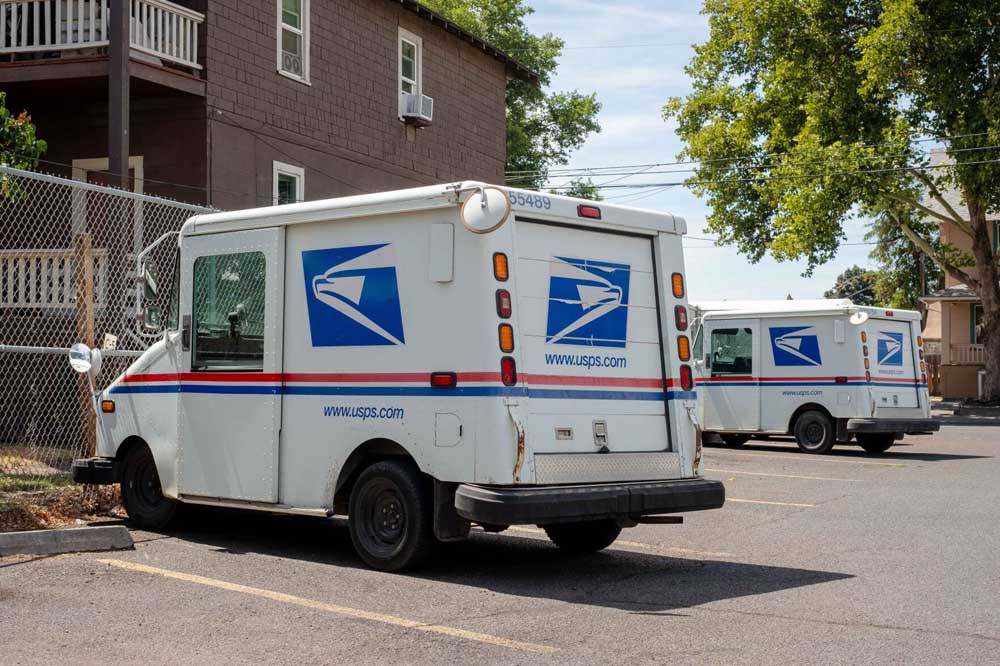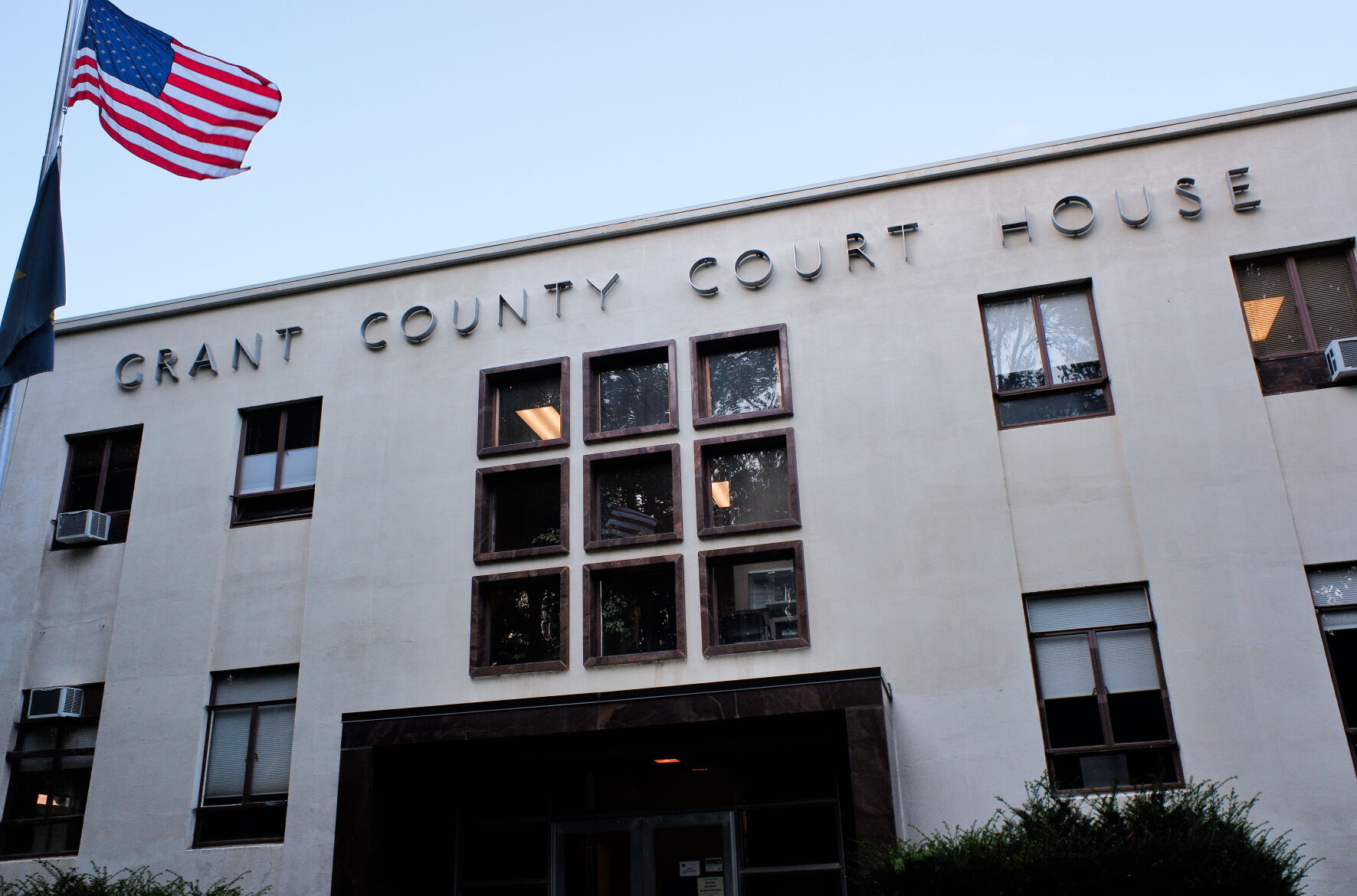Delivery delays: Critics of new Postal Service policy say it could slow mail delivery, especially in rural Oregon
Published 6:00 am Friday, March 22, 2024

- Mail carrier trucks are parked on Aug. 8, 2023, at the post office in Pendleton.
BAKER CITY — A U.S. Postal Service policy that took effect in late February in the state means outgoing mail at more than two dozen mostly rural post offices in Northeast Oregon will be picked up later than it has been.
Critics say the change could result in some pieces of mail, including packages as well as first class letters, being delivered a day later than in the past.
They have also raised concerns about time-sensitive mail, including election ballots and tax returns.
Elections officials typically recommend that voters who haven’t returned their ballots by mail at least a week before election day instead take the ballots to a drop box to ensure they are counted.
Oregon’s U.S. senators, Ron Wyden and Jeff Merkley, have criticized the new policy, as have representatives of the American Postal Workers Union.
Some of the larger post offices in the region, including Baker City, Pendleton and La Grande, apparently are not affected, although the Postal Service has not released an official list.
A Postal Service official says the new policy, by reducing the number of truck trips, will “reduce costs and carbon emissions.”
‘Optimization’
The new strategy is known as Local Transportation Optimization (LTO).
It’s part of Postmaster General Louis DeJoy’s “Delivering for America” 10-year plan intended to make the agency, which lost $6.5 billion in fiscal year 2023, financially sustainable.
“LTO is part of the Postal Service’s larger effort to optimize our truck capacity and reduce the overall number of carbon-wasting, duplicate trips,” Kim Frum, a Postal Service strategic communications specialist, said. “Our local transportation network often includes a large number of separate and underutilized trips to pick up and drop off mail and packages from Post Office locations and other postal facilities. LTO aims to improve the efficiency of our transportation network, in certain circumstances, by using one trip to drop off mail to be delivered and to pick up outgoing mail for processing.”
LTO launched in Oregon on Feb. 24, according to Postal Service documents. The new schedule started in October in Virginia, and in January in Wisconsin.
How it works
In affected post offices, outgoing mail brought to the office or collected by a carrier during the day is left overnight at the post office and picked up the following morning by the truck that also drops off mail to be delivered that day.
Prior to LTO, two mail trucks visited some of those offices daily. One arrived in the morning to drop off mail to be delivered that day. The other truck stopped in the evening to pick up outgoing mail collected during the day by carriers or dropped off at the post office.
Since LTO started, the evening truck no longer stops at four post offices along Highway 26 east of Portland, the highway to Mount Hood, said Daniel Cortez, director of legislative and political relations for the Oregon Postal Workers Union, the state arm of the American Postal Workers Union.
Gauging the effects of LTO is difficult, Cortez said, because the Postal Service has not given union officials a list of which offices are affected.
“We are having to rely on our members to tell us what’s happening,” Cortez said.
Frum, the Postal Service spokesperson, wrote in an email to the Herald that the agency’s list of post offices affected by LTO “is not publicly available.”
Employees at several post offices in the region referred questions to Frum or other Postal Service officials. Some said they had been instructed not to speak to the media about LTO.
That lack of transparency, which leaves customers uncertain about whether their local post office is affected, is troubling, said Omar Gonzalez, western regional coordinator for the American Postal Workers Union.
“It’s hard to discern because they’re not forthcoming,” he said, referring to the Postal Service.
Gonzalez said there is no doubt, however, that the LTO policy will delay mail delivery in some places.
“It’s ridiculous,” he said.
Frum wrote in her email to the Herald that, related to LTO, “the Postal Service does not expect these efforts to impact customer service.”
Cortez contends that eliminating the evening mail truck inevitably will have an effect by delaying delivery.
“The Postal Service appears to be hiding behind platitudes,” he said.
Other offices were limited to a single mail truck per day prior to LTO, but according to an employee who requested anonymity, the truck at the office where the employee works is leaving earlier in the day now. That means customers who want their mail to start the journey to the Portland processing center have less time to take it to their local office and ensure it’s loaded on the truck the same day.
According to an internal Postal Service document dated Feb. 16, eliminating the nightly mail collection from affected post offices “will eliminate the excessive mileage between the unit and the processing facility.”
To put it another way, the Postal Service will no longer pay to have a truck that makes a trip each evening to pick up outgoing mail from those offices.
In a Jan. 10, 2024, letter to President Joe Biden and congressional leaders, DeJoy wrote that LTO is projected by cut annual transportation costs by $1 billion.
One-day delay possible
The problem with LTO, critics say, is that the new system could delay by a day the delivery of outgoing mail.
“This is a concern for any time-sensitive mailing such as tax returns and express mail,” said Jamie Partridge, an organizer with Communities and Postal Workers United and a retired letter carrier from Portland.
Another critic, who lives on the opposite side of the country, has been following the LTO rollout and commenting on it through his website, savethepostoffice.com.
Steve Hutkins, a retired English professor who lives in New York State’s Hudson Valley, said LTO primarily affects mail, including packages, that individuals and small businesses send. This includes first class, express and priority mail, Hutkins said. LTO doesn’t affect “junk mail,” which is presorted, he said.
Although Frum, the Postal Service spokesperson, wrote that the Postal Service “does not expect these efforts to impact customer service,” a Nov. 22, 2023, document written by attorneys for the Postal Service, in response to questions from the Postal Regulatory Commission about the LTO policy, is not so certain.
One response reads, in part: “While short-term impacts to service performance during the execution process may occur, the Postal Service will monitor any impacts that occur, and may make adjustments as necessary and warranted.”
According to a list that Hutkins said he compiled based on Postal Service documents, LTO is not being applied to post offices in some larger Northeast Oregon cities, including Baker City, Pendleton and La Grande.
According to the Nov. 22, 2023, document from Postal Service attorneys, one of the criteria used to determine whether a post office is subject to LTO — what’s known as “full optimization,” is mail volume.
“Locations with lower volume (1 container of originating volume per day on average) are generally subject to ‘Full Optimization,’ ” the attorneys wrote.
Post offices with seven or more containers of outgoing mail per day on average are exempt from LTO.
An internal Postal Service document dated Feb. 16, which also outlines the LTO process, states that post offices more than 50 miles from a mail processing center will be analyzed for possible full optimization. The centers in Oregon are in Portland, Eugene and Medford.
But based on the list that Hutkins compiled, neither the 50-mile nor the volume threshold seems to be an absolute criterion.
Other offices that aren’t on the LTO list that Hutkins put together include some from post offices in areas with small populations. These include, in Baker County, Sumpter (ZIP code population 287), Richland (639), Halfway (1,226), Oxbow (154), Hereford (76), Bridgeport (29) and Unity (127), Imbler (544) and Summerville (996) in Union County, Helix (379) in Umatilla County, Ione ( 845) and Lexington (303) in Morrow County, and Imnaha (82) in Wallowa County.
Yet post offices in more populous areas are listed, on Hutkins’ map, as being fully optimized, most notably Hermiston, the most populous city in Northeast Oregon, with about 20,300 residents. By county:
Baker
Haines (696)
Grant
Canyon City (1,016), John Day (2,571), Mount Vernon (1,128), Seneca (206), Prairie City (905)
Union
North Powder (1,046), Elgin (2,504), Cove (1,866), Union (2,395)
Wallowa
Enterprise (3,192), Joseph (2,114), Wallowa (1,404)
Umatilla
Adams (1,179), Athena (1,436), Hermiston (27,318), Milton-Freewater (12,559), Pilot Rock (1,579), Weston (963), Echo (1,319)
Morrow
Heppner (2,076), Boardman (5,034), Irrigon (3,676)
Congressional reaction
The Rural Organizing Project, an Oregon organization based in Cottage Grove, is encouraging residents statewide to object to the LTO by contacting their congressional representatives.
Senators Wyden and Merkley have been following the LTO process and other parts of the “Delivering for America” program.
Both senators signed a March 13 letter to the postmaster general urging him to halt any policies, including LTO, that would eliminate Postal Service jobs or slow mail delivery.
The letter also addresses changes in where mail is processed, in particular trucking some mail from processing centers in Medford and Salem to Portland.
Northeast Oregon went through that transition more than a decade ago, when the Postal Service in 2013 closed the mail processing center in Pendleton.
That resulted in mail from Northeast Oregon being trucked to Portland to be postmarked and sorted, including letters that were mailed to another address in the region.
A letter mailed from one address in Baker City to another actually travels to Portland before it reaches its final destination.
Cortez, the official from the Oregon Postal Workers Union, said LTO “is just a continuation of what the Postal Service started back then.”
Wyden said he fielded multiple questions about Postal Service changes, including eliminating nightly mail pickup at some offices, during town halls last week.
“The message from rural Oregon has been delivered loud and clear at my town hall meetings all over the state: this asinine Postal Service consolidation is slamming small communities,” Wyden said. “I will keep pressing Postmaster Louis DeJoy and the Board of Governors to deliver actual solutions for Oregonians counting on dependable and timely delivery of mail, prescriptions and more.”
Merkley has also chastised the Postal Service for its recent changes.
“The 10-year plan being called ‘Delivering for America,’ it should be called the ‘Delivering Badly for Americans Plan,’ ” Merkley said.
Molly Prescott, Merkley’s press secretary, wrote in an email to the Herald that the senator “has certainly been a vocal opponent of many aspects of Postmaster DeJoy’s ‘Delivering for America’ plan that he believes is a recipe for lower service standards and mail delivery performance, especially in rural parts of the state.”
Prescott said Merkley is looking at multiple potential options, including a possible moratorium, attached to a federal appropriations bill, that could retroactively restrict the Postal Service from instituting policies, such as LTO, that could slow mail delivery.
“The message from rural Oregon has been delivered loud and clear at my town hall meetings all over the state: this asinine Postal Service consolidation is slamming small communities.”
— U.S. Sen. Ron Wyden, D-Ore.
“LTO is part of the Postal Service’s larger effort to optimize our truck capacity and reduce the overall number of
carbon-wasting, duplicate trips.”
— Kim Frum, U.S. Postal Service spokesperson,
talking about the Local Transportation Optimization policy









